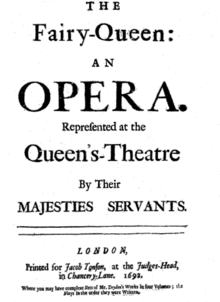
Back The Fairy-Queen Catalan Královna víl (opera) Czech The Fairy-Queen German La reina de las hadas Spanish The Fairy Queen Finnish The Fairy Queen French A Tündérkirálynő Hungarian Փերիների թագուհին Armenian La regina delle fate (Purcell) Italian 妖精の女王 (パーセル) Japanese
| The Fairy-Queen | |
|---|---|
| Semi-opera by Henry Purcell | |
 Title page of the original printed edition | |
| Description | Restoration spectacular |
| Based on | A Midsummer Night's Dream by William Shakespeare |
| Premiere | 2 May 1692 Queen's Theatre, Dorset Garden, London |
The Fairy-Queen (1692; Purcell catalogue number Z.629) is a semi-opera by Henry Purcell; a "Restoration spectacular".[1] The libretto is an anonymous adaptation of William Shakespeare's comedy A Midsummer Night's Dream.[2] First performed in 1692, The Fairy-Queen was composed three years before Purcell's death at the age of 35. Following his death, the score was lost and only rediscovered early in the twentieth century.
Purcell did not set any of Shakespeare's text to music; instead he composed music for short masques in every act but the first. The play itself was also slightly modernised in keeping with seventeenth-century dramatic conventions, but in the main the spoken text is as Shakespeare wrote it. The masques are related to the play metaphorically, rather than literally. Many critics have stated that they bear no relationship to the play. Recent scholarship has shown that the opera, which ends with a masque featuring Hymen, the God of Marriage, was composed for the fifteenth wedding anniversary of William III and Mary II.[3]
Growing interest in Baroque music and the rise of the countertenor contributed to the work's re-entry into the repertoire. The opera received several full-length recordings in the latter part of the 20th century and several of its arias, including "The Plaint" ("O let me weep"), have become popular recital pieces.
In July 2009, in celebration of the 350th anniversary of Purcell's birth, The Fairy-Queen was performed by Glyndebourne Festival Opera using a new edition of the score, prepared for the Purcell Society by Bruce Wood and Andrew Pinnock.
- ^ Milhous, pp. 50–61
- ^ It has nothing to do with Edmund Spenser's poem The Faerie Queene
- ^ Cite error: The named reference
Muller 2005was invoked but never defined (see the help page).